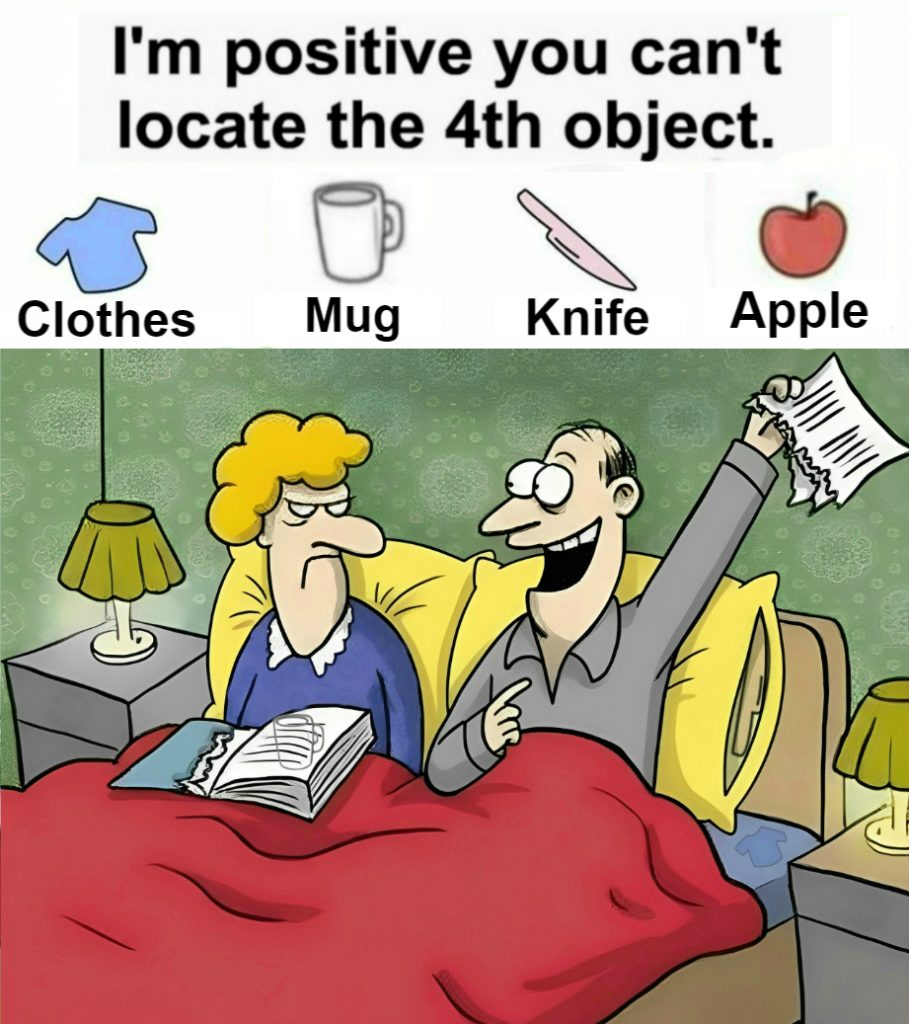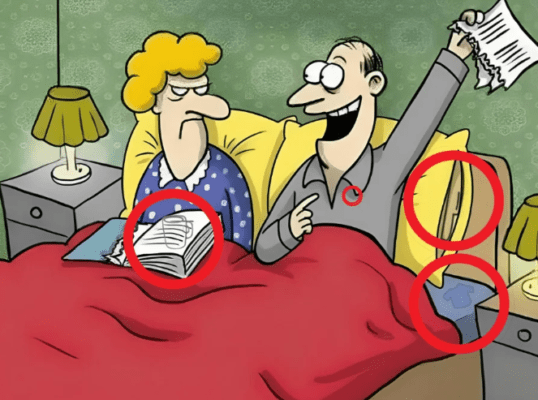A Cozy Hidden-Object Challenge (Are You Ready to Spot Them All?)
Let’s put your observation skills to the test with a scene that looks calm at first glance: a bedroom-sitting room mashup with a man resting near a bed, a woman reading, soft fabrics, and everyday objects that love to hide in plain sight. Your mission is simple—find the Clothes, Mug, Knife, and Apple—but don’t be fooled. The trick isn’t better eyesight; it’s better strategy. Before you scroll, take a mental “sweep” of the room. Ask yourself: Where would something small blend into texture? Where would something dangerous be hidden? What item sits where my brain wouldn’t expect it?

Why We Miss the Obvious (And How This Puzzle Tricks You)
Hidden-object puzzles prey on a few predictable habits. Knowing them makes you instantly better:
- Expectation bias: We “know” where things should be (a mug on a table, clothes in a closet), so we don’t check the odd places (on a book, under bedding).
- Texture camouflage: Objects borrow the textures around them. Fabric hides fabric; smooth hides in smooth. Clothes vanish beneath sheets, a knife disappears against pillow seams, an apple merges with warm skin tones or a collar fold.
- Edge neglect: Most players scan the “center drama” (faces, a book, the bed) and ignore borders, hems, collars, pillow edges, and the underside of linens.
- Light and shadow illusions: Soft light near a bed blurs small shapes. A collar shadow might “swallow” an apple’s curve. Pillow stitching can fake a blade’s edge.
- Clutter fatigue: When everything looks right, the brain stops flagging anomalies. That’s exactly when a mug can sit brazenly on a book in someone’s hands without you noticing.
A Simple System to Outsmart the Scene
Use this quick method before you peek at the answers:
- Map the big shapes (bed, pillows, people, nightstand, chair).
- Sweep the edges (sheet hems, pillow seams, collar lines, book edges).
- Hunt by material (fabric-for-clothes, ceramic-for-mug, metal-for-knife, glossy/rounded-for-apple).
- Check the unexpected (on top of objects being held, under covers, inside folds).
- Confirm with silhouette (straight lines for the knife, gentle oval for an apple, soft bulk for clothes).
Spoilers ahead! If you want one more pass, stop here and scan the scene with the five steps above.
Video : Friday Fun
Step-by-Step Walkthrough: Where Each Item Is Hiding (and Why It Fooled You)
1) Clothes — Hidden Under the Bed Sheet Near the Man
Where: The clothes are tucked under the bed sheet close to the man.
Why you missed it: Fabric-on-fabric camouflage. The sheet’s drape creates soft ridges that mask the bulk of clothing. Your brain files it as “wrinkles,” not “something under there.”
How to confirm:
- Look for a thicker swell in the sheet near the man—wrinkles are narrow and repetitive; a hidden bundle is broader and asymmetric.
- Notice any color peeking at a seam or corner—tiny hints of a different fabric tone are a giveaway.
- If the sheet edge looks lifted or propped instead of freely hanging, something underneath is doing the propping—hello, clothes.
2) Mug — Resting on the Woman’s Book
Where: The mug is sitting on the book the woman holds.
Why you missed it: Expectation bias. We assume drinks live on tables, not on a book-in-hands moment. Also, mugs with matte glazes and gentle lighting can look like part of the book’s cover illustration.
How to confirm:
- Look for a circular rim—even in low contrast, a mug’s rim forms a neat ellipse.
- Scan the book’s top edge: does something break the clean rectangle? The mug will slightly overhang or cast a distinct rounded shadow.
- Check for a handle silhouette—a small C-curve near the book’s side is a dead giveaway.

3) Knife — Hidden in/Under the Man’s Pillow
Where: The knife is concealed in (or under) the man’s pillow.
Why you missed it: Pillow seams and piping create straight lines and highlights that mimic a blade. On a curved, puffy surface, your brain discounts any straight glint as “fabric detail.”
How to confirm:
- A knife’s edge stays uniformly straight; pillow seams curve with the pillow’s contour. If you see a straight line refusing to bend, you’re looking at metal.
- Look for a tiny tang or handle hint at one end—slight shape changes or a different shine.
- The light on metal usually creates a sharper, colder highlight than fabric’s soft sheen. Follow the brightest streak: if it’s crisp and linear, that’s your blade.
4) Apple — Hidden at the Man’s Collar
Where: The apple is concealed at the man’s collar.
Why you missed it: Collars create roundish folds and half-shadows that mimic an apple’s curve. If the apple’s color is muted (greenish or warm red in low light), it blends into skin tones and fabric warmth.
How to confirm:
- Trace the collar line. A true collar fold thins out; an apple maintains a consistent, rounded volume.
- Look for a clean arc interrupting the collar’s angle—apples make smooth circular edges that fabric alone rarely forms.
- Notice any specular highlight (a small glossy spot). Fabrics are mostly matte; apples carry a tiny, bright reflection even in soft light.

Common Mistakes That Lead You Astray (And Quick Fixes)
- Only scanning the tabletop/nightstand: Fix it by doing an edge tour—sheet hem → pillow seams → collar line → book edges.
- Chasing color first: Start with shape/silhouette. The mug’s ellipse or the knife’s straight line are stronger tells than color.
- Ignoring held objects: Anything in someone’s hands (like the woman’s book) is a prime hiding place.
- Not revisiting after a find: Each discovery changes your mental map. After you find one item, rescan the scene—you’ll often spot another in seconds.
Your Rapid-Fire Recap (Correct Answers)
- Clothes: Hidden under the bed sheet near the man.
- Mug: On the woman’s book.
- Knife: Hidden inside/under the man’s pillow.
- Apple: Concealed at the man’s collar.
Train Your Eye: A 60-Second Drill You Can Use on Any Puzzle
- Quadrant scan: Mentally divide the scene into four zones. Spend 10–15 seconds on each, edges first.
- Material pass: Do a second sweep focusing only on metal, ceramic, fabric bulk, and glossy fruit.
- Line audit: Find one perfectly straight line (knife), one perfect ellipse (mug rim), one soft bulge (clothes), and one clean arc (apple).
Do this on three different images and your speed will jump—dramatically.
Video : Can You Spot the Missing 4th Object?❤️👇🏻
Join the Hunt: Tell Us What You Saw First
Which object popped out to you first—the mug on the book, or the apple at the collar? What was the hardest? Did the pillow’s straight highlight fool you? Share your time-to-solve, the order you found them, and any tricks that helped (like spotting the mug’s handle or the apple’s tiny shine). Your tip might be the exact nudge another player needs.
Keep the Momentum Going
If this challenge sharpened your senses, try scenes with layered fabrics (great for hidden clothes), reflective props (perfect for knives and spoons), and held objects (books, trays, newspapers—excellent mug decoys). The more you practice, the more your brain learns to spot pattern breaks, shape anomalies, and micro-highlights—the holy trinity of hidden-object mastery.
Conclusion
You just tackled a deceptively simple puzzle by thinking like a detective: mapping big shapes, sweeping edges, hunting materials, and confirming with silhouette and light. Remember the final placement—clothes under the sheet near the man, mug on the woman’s book, knife in/under the man’s pillow, apple at the man’s collar—and the logic behind each find. Keep playing, keep sharing, and keep training that sharp gaze. The next hidden object is already waiting in plain sight—and now you know exactly how to find it.